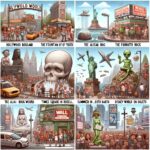Are you ready to blend creativity with functionality, shaping digital experiences that delight users and drive engagement? A career as a UI/UX Designer might be your calling. As a skilled professional in the realm of user interface (UI) and user experience (UX) design, you’ll play a pivotal role in creating intuitive, visually appealing, and user-centric interfaces for websites, applications, and digital products. Let’s dive into the dynamic world of UI/UX design and uncover what it takes to excel in this exciting and ever-evolving field.
Designing Delight: Responsibilities of a UI/UX Designer
As a UI/UX Designer, you’ll have a multifaceted set of responsibilities aimed at crafting seamless and engaging user experiences, including:
- User Research: Conducting user research, surveys, and interviews to understand user needs, preferences, and pain points, and gathering insights to inform the design process and create user personas and journey maps.
- Wireframing and Prototyping: Creating wireframes, mockups, and prototypes of digital interfaces, using design tools such as Adobe XD, Sketch, or Figma, to visualize layout, navigation, and functionality and iterate on design concepts.
- Visual Design: Designing visual elements, including color schemes, typography, icons, and imagery, to create visually appealing and cohesive UI designs that align with brand identity and enhance the overall user experience.
- Interaction Design: Defining interactive elements, transitions, and animations to guide user interactions and enhance usability, incorporating principles of usability and accessibility to create intuitive and engaging interfaces.
- Usability Testing: Conducting usability testing sessions and gathering feedback from users to evaluate the effectiveness of design solutions, identify usability issues, and iteratively refine and improve the user experience.
- Collaboration: Collaborating with cross-functional teams, including product managers, developers, and stakeholders, to align on project goals, requirements, and design objectives, and facilitate a cohesive and collaborative design process.
Skills and Qualifications
To excel as a UI/UX Designer, you’ll need a diverse skill set spanning design principles, user research methodologies, and technical proficiency, including:
- Design Tools: Proficiency in design tools such as Adobe Creative Suite (Photoshop, Illustrator), Sketch, Figma, or Adobe XD, as well as prototyping tools like InVision or Axure, to create and iterate on design concepts and prototypes.
- User-Centered Design: Understanding of user-centered design principles and methodologies, including user research, personas, journey mapping, and usability testing, to empathize with users and design solutions that meet their needs and expectations.
- Visual Design: Strong visual design skills, including knowledge of typography, color theory, layout principles, and iconography, to create aesthetically pleasing and visually engaging UI designs that communicate effectively with users.
- Interaction Design: Familiarity with interaction design principles, including affordances, feedback, and cognitive load, to design intuitive and user-friendly interfaces that guide users through interactions and tasks with ease.
- Problem-Solving Skills: Strong problem-solving abilities to analyze user feedback, identify design challenges, and propose creative solutions that balance user needs, business goals, and technical constraints.
- Communication Skills: Effective communication skills to articulate design concepts, present ideas and solutions to stakeholders, and collaborate effectively with multidisciplinary teams throughout the design process.
Advancing Your Career
As a UI/UX Designer, there are various opportunities for career advancement and specialization within the field of digital design and user experience. You may consider:
- Specialization: Specializing in specific areas of UI/UX design, such as mobile app design, web design, interaction design, or user research, to deepen your expertise and focus on areas of interest or emerging trends within the industry.
- Advanced Education: Pursuing advanced education or professional certifications in UI/UX design, human-computer interaction (HCI), or digital design, to enhance your skills and qualifications and position yourself for leadership roles or specialized positions within organizations.
- Leadership Roles: Advancing to leadership roles within design teams or organizations, such as Lead Designer, Design Director, or Head of UX, where you can oversee design projects, mentor junior designers, and shape the strategic direction of design initiatives.
- Entrepreneurship: Exploring opportunities for freelance or entrepreneurial ventures in UI/UX design, offering design services to clients, developing digital products or applications, or founding a design agency or startup focused on solving specific user needs or market niches.
Conclusion
In conclusion, being a UI/UX Designer is an exciting and dynamic career that offers opportunities to blend creativity, technology, and human-centered design principles to create impactful digital experiences. By mastering the tools and techniques of UI/UX design, fostering empathy for users, and advocating for user-centric design principles, you can make a lasting impact on the way people interact with digital products and services, driving engagement, satisfaction, and success for businesses and users alike. So, if you’re ready to embark on a journey of design innovation, shaping the future of digital experiences and transforming the way people connect, engage, and interact in the digital world, seize the opportunity to become a UI/UX Designer – where every design you create is a testament to your passion and creativity, every interaction you design is an opportunity to delight and inspire, and every day brings new opportunities to craft experiences that make a meaningful impact on people’s lives.














